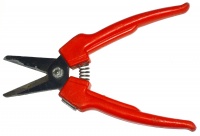Secateurs
There are 3 types of secateurs, anvil, bypass and parrot beak.
Anvil
Anvil secateurs have one thinly tapered sharp blade that meets a flat lump of metal, the anvil. These have much better cutting power than bypass with woody material, but they tend to leave a thin bit of material on one side of the stem uncut. Often the anvil can be adjusted for best alignment, but expecting perfection is optimistic.
Bypass
Bypass secateurs work like scissors, they have 2 blades that slide past each other. The cutting edges are a much wider angle than anvil secateurs. Easier to use for thin soft material, but much harder going on woody material.
With no anvil, bypass secateurs are much lighter than anvil types.
Parrot-beak
Parrot-beak secateurs consist of two concave bypassing blades, which trap the stem between them to make the cut. They give a clean cut, but may be damaged if used to cut woody stems over 1cm or so.
Flower gatherers
These hold the stem once cut.
Others
There are other pruning options, including knife, saw, lopper, etc
Knife
A knife is sometimes used as a plant cutting option. A sharp knife gives a much cleaner cut than either anvil or bypass secateurs, minimising risk of disease. The maximum cutting ability is less than secaturs however, and they're less convenient to use, and possibly less safe.
The main use of a knife is where a very clean cut is needed. Harvestng squashes is a good example of this, for which a very thin bladed knife is ideal.
Points to look for
- Plastic handles that only contain metal stubs are found at the bottom of the market. These aren't robust
- Good alignment of blade with anvil
- Adjustable anvil
- Replaceable blades
- Lock mechanism that isn't overly stiff or loose
- Lock mechanism that doesn't fail after a while
- Plastic covered handles avoids cold
- Comfortable handles
- Handle rubber that doesn't disintegrate in normal use
- A left handed model if you're left handed
- Blades may be stainless steel, carbon steel or coated steel. Stainless and carbon steel stay sharp longer, coated steel cleans easier.
- Size, weight and toughness suited to the task.

